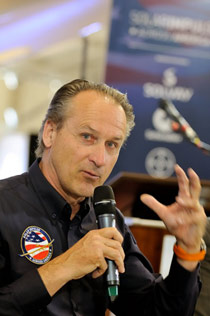
Preparing for the final leg of their historic flight across the United States, the crew of the Solar Impulse—the first manned, solar-powered airplane able to fly around the clock—reflected on the collaboration that made construction of the airplane possible, as well as the technology exchange that already is benefitting other industries.
The airplane, with the wingspan of an airliner—208 feet—weighs only 3,527 pounds, a bit more than a Cessna 182 and closer to the weight of a Honda Accord or Toyota Avalon. It arrived at Washington Dulles International Airport early on June 16, and will be at the National Air and Space Museum’s Steven F. Udvar-Hazy Center until it departs for New York City later this month, although it’s only accessible to the public on scheduled days. Solar Impulse’s only currently scheduled open day is Saturday, June 22, from 10 a.m. until 5 p.m.
“What you see here is the first airplane that can fly day and night,” said Solar Impulse pilot and co-founder André Borschberg. “It can fly almost perpetually.” Had its development been left to the aviation industry, he added, it might never have left the ground. “The aviation industry told us what we wanted to do was not feasible.”
To develop the aircraft, Borschberg and his fellow pilot and co-founder, Dr. Bertrand Piccard, formed partnerships with 80 companies—only one of which was from the aviation world, he said. Some, like Schindler Elevator, share a need to develop products that use less energy.
Schindler engineers were embedded into the Solar Impulse project team, lending their expertise with electric engines, power management, and other areas—and leaving with new perspectives on other subjects, said Frank Resch, Schindler vice president of research and development. “We combined what we learned by embedding our engineers in the Solar Impulse project…to create the solar elevator,” he explained. “The lighter your elevator is, the better the payload, and the more efficient the system. In the future we will use composite material, like Solar Impulse, for elevator cars.”
“By embedding Schindler engineers into the Solar Impulse project, we’re enabling knowledge exchange,” said Bill Fiacco, president of Schindler North American sales and marketing operations. “The mission is ending, and the journey is beginning.”
 “Until a few years ago, the protection of the environment was expensive and boring,” Piccard commented. Now, Solar Impulse uses electrical motors that are 94 percent efficient, and it brought together competing battery manufacturers to help improve battery technology. “We have [LED] lighting systems that put the runway in daylight for less than 200 watts. If you can make these clean technologies sexy, then people start to come,” he said. “We have exceeded 6 billion media impressions in three months, thanks to this incredible airplane.”
“Until a few years ago, the protection of the environment was expensive and boring,” Piccard commented. Now, Solar Impulse uses electrical motors that are 94 percent efficient, and it brought together competing battery manufacturers to help improve battery technology. “We have [LED] lighting systems that put the runway in daylight for less than 200 watts. If you can make these clean technologies sexy, then people start to come,” he said. “We have exceeded 6 billion media impressions in three months, thanks to this incredible airplane.”
Lindbergh Foundation to honor pilots
The Charles A. and Anne Morrow Lindbergh Foundation will present the Lindbergh Spirit medal, awarded for pioneering achievements in aviation, to Piccard and Borschberg at 2 p.m. June 21 at the Udvar-Hazy Center. The foundation, a charitable 501(c)3 nonprofit, encourages advancements in the aviation industry which perpetuates the Lindberghs’ interest in achieving a balance between technology and the environment.
“In the same way that Charles and Anne played a seminal role in the development of the airline industry, Bertrand and André will be remembered for being the first to demonstrate that it is possible to fly day and night on solar energy only,” said Lindbergh
Foundation Chairman John L. Petersen. “This project is important not only for raising awareness of the significance of using solar power for a broad spectrum of applications, but also to encourage companies and individuals to pursue the advancement of clean technologies.” 
What’s next?
After Solar Impulse flies the final leg of its U.S. trip, to John F. Kennedy International Airport in New York City, it will be disassembled and shipped back to Switzerland. There, the team already is at work on another, larger solar-powered airplane. While the current Solar Impulse could fly indefinitely, flight legs are limited to 24 hours for safety considerations—the narrow cockpit carries only one pilot, and there is no autopilot. (Takeoffs are made before sunrise, and landings in the middle of the night, to protect the lightweight airplane from the effects of thermals.) The new airplane will have a larger cockpit—and an autopilot.
Plans are to fly the new airplane around the world in 2015, with one stop on each continent. “The only thing that would be more spectacular than flying across the United States would be flying around the world,” Piccard said. “This will push the learnings further.”




